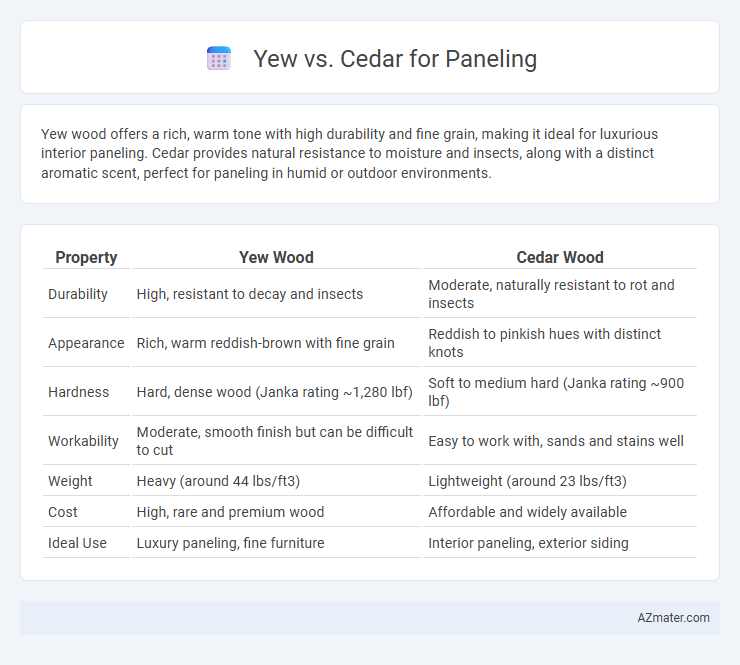Yew wood offers a rich, warm tone with high durability and fine grain, making it ideal for luxurious interior paneling. Cedar provides natural resistance to moisture and insects, along with a distinct aromatic scent, perfect for paneling in humid or outdoor environments.
Table of Comparison
| Property | Yew Wood | Cedar Wood |
|---|---|---|
| Durability | High, resistant to decay and insects | Moderate, naturally resistant to rot and insects |
| Appearance | Rich, warm reddish-brown with fine grain | Reddish to pinkish hues with distinct knots |
| Hardness | Hard, dense wood (Janka rating ~1,280 lbf) | Soft to medium hard (Janka rating ~900 lbf) |
| Workability | Moderate, smooth finish but can be difficult to cut | Easy to work with, sands and stains well |
| Weight | Heavy (around 44 lbs/ft3) | Lightweight (around 23 lbs/ft3) |
| Cost | High, rare and premium wood | Affordable and widely available |
| Ideal Use | Luxury paneling, fine furniture | Interior paneling, exterior siding |
Introduction: Comparing Yew and Cedar for Paneling
Yew and cedar are popular choices for wood paneling due to their distinct aesthetic and durability characteristics. Yew offers a rich, reddish-brown hue with fine grain patterns ideal for elegant interiors, while cedar provides a lighter, natural aroma and excellent resistance to decay and insects. Both woods differ in maintenance needs, with yew requiring more care to preserve its smooth finish compared to cedar's natural weather-resistant qualities.
Wood Appearance: Grain, Color, and Aesthetics
Yew wood features a fine, straight grain with occasional interlocking patterns, offering a smooth texture and a rich yellow to reddish-brown color that deepens over time. Cedar displays a more pronounced, often wavy grain with a distinct aromatic scent and natural red to light brown hues, making it visually warm and inviting. Both woods provide unique aesthetics for paneling, with Yew giving a sleek, refined look while Cedar offers a rustic, natural charm.
Durability and Lifespan
Yew wood offers exceptional durability and resistance to decay, making it a long-lasting choice for paneling with a lifespan often exceeding 50 years when properly maintained. Cedar is naturally resistant to moisture, rot, and insect damage, contributing to its durability and a typical lifespan of 30 to 40 years in interior or exterior paneling applications. Choosing Yew or Cedar for paneling depends on the desired balance between longevity and natural aromatic properties, as Yew tends to be denser and harder than Cedar, providing superior structural endurance.
Resistance to Moisture and Decay
Yew wood offers moderate resistance to moisture and decay, making it suitable for interior paneling in environments with controlled humidity. Cedar wood excels in natural resistance to moisture, decay, and insect damage due to its high content of natural oils, providing superior durability in humid or damp conditions. For paneling in moisture-prone areas, cedar generally outperforms yew in longevity and maintenance requirements.
Scent and Allergen Considerations
Yew paneling emits a subtly sweet, resinous aroma that is less likely to trigger allergic reactions, making it suitable for sensitive indoor environments. Cedar paneling is well-known for its strong, distinctive scent, rich in natural oils that can act as a natural insect repellent but may cause respiratory irritation or allergic responses in some individuals. Choosing between yew and cedar for interior paneling requires careful consideration of scent tolerance and potential allergen exposure to ensure comfort and health safety.
Workability: Cutting, Sanding, and Finishing
Yew wood offers excellent workability with its fine, straight grain that allows for smooth cutting and easy sanding, producing a clean, polished finish ideal for paneling. Cedar, while softer and more aromatic, can be prone to splintering during cutting and requires careful sanding to achieve a smooth surface due to its resinous nature. Both woods accept finishes well, but Yew provides a more uniform and durable finish, making it preferable for high-quality interior paneling projects.
Maintenance and Care Requirements
Yew paneling requires regular oiling to maintain its rich color and prevent drying but is generally resistant to pests and rot, making it relatively low-maintenance. Cedar paneling naturally contains oils that repel insects and moisture, reducing the need for frequent treatments, yet periodic sealing is recommended to preserve its appearance and prevent weathering. Both woods benefit from routine dusting and cleaning with mild solutions to enhance longevity and maintain aesthetic appeal.
Cost Comparison and Availability
Yew paneling is typically more expensive than cedar due to its slower growth rate and limited availability, often fetching higher prices in specialty lumber markets. Cedar offers greater cost-effectiveness, benefiting from widespread availability and faster growth, making it a popular choice for large-scale projects. While both woods provide durability and aesthetic appeal, cedar's abundance and lower price make it the preferred option for budget-conscious paneling installations.
Environmental Impact and Sustainability
Yew paneling is highly valued for its slow growth and dense grain, which contribute to its durability and long lifespan, reducing the need for frequent replacement and minimizing environmental impact. Cedar, known for its natural resistance to decay and insects, often comes from sustainably managed forests, and its lightweight nature lowers transportation emissions. Both woods offer sustainable options when sourced responsibly, but cedar's more rapid growth rates and widespread availability typically present a lower ecological footprint compared to yew.
Best Applications: Which to Choose for Your Project
Yew offers a fine grain and rich color ideal for intricate paneling that demands a warm, elegant aesthetic, making it suitable for high-end interior spaces such as libraries and feature walls. Cedar, known for its natural resistance to moisture and decay, excels in paneling for environments prone to humidity, like bathrooms or exterior cladding, providing durability alongside a rustic appeal. Choose yew for refined, indoor applications requiring detailed craftsmanship, and cedar for projects where resilience and natural aroma enhance functionality and ambiance.

Infographic: Yew vs Cedar for Paneling
 azmater.com
azmater.com